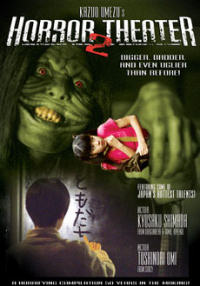
The second edition of a series that celebrates the imaginative power and scope of horrific Manga, Kazuo Umezz's Horror Theater (2) is an ambitious, fundamentally scary collection. While its FX and acting range from serviceable to incompetent, somewhat lessoning the polished effect of stories seeped in ambiguity and atmosphere, the narrative integrity of these titillating tales and their richness of theme retain our interest. Honoring the archetypal power of its cultural origins, this emotionally intensive horror show is intelligent and moodily photographed, retelling aspects of Asian folklore with a complex, somewhat paradoxical emphasis on both universal fears and modern day anxiety. This combination, lending the narrative greater authenticity and visual strength, results in visually jarring stories that make the fantastical disturbingly realistic. Scenes from everyday urban life are rendered undeniably chilling, suggesting that a very fine line separates the common everyday life from a world of nightmares. In fact, the realistic and supernatural inhabit such a close proximity that they invade and overlap one another in surreal dream-moments whose suggestiveness raises awe as well as goosebumps.
Featuring two tales of self-induced torment, cultural isolation, and culpability, Snake Girl and The Wish both mine the philosophical resonance and far-reaching psychological depth of the traditional folk tale, imbedded deep within our consciousness. At the same time, each story is written so as to interweave basic supernatural elements in conflicts of self, friendship, and modern life that make the cosmic elements appreciable on a personal, intimate level. No small feet, and one which the cast and crew accomplish with verve. A dark poetry infuses these irrational horrors, compounded by an impressive theatricality. "Snake Girl," the first tale, introduces Yumiko, a retrospective young girl, who is invited by her cousin to spend summer vacation in a country village. Uprooting the prejudice, rough manners, and unnerving spiritual knowledge of people who live close to the earth and its secrets, this fearsome fable is an expose of dual personality and possession, with the conventional horror trope of occult transformation both enjoyable on a creepy surface level and suggestive of the complex nature of the personality -- itself a mystery, as capable of shedding its layers as a snake sheds skin -- which is precisely what the villagers refer to when they call her "snake girl." Drabbed in moody photography and semi-gothic imagery, "Snake Girl" is wonderfully paced. Director Noboru and writer Chiaki Konaka instil a morbid piece of terror with moralistic sensibility and wonder. The effect, if hampered by the visual effects, is nevertheless insightful and emotionally satisfying.
"The Wish," the second entry, is a modernist interpretation of the Pygmalion myth, wherein the depths and intensity of a human's desire instills the essence of life into an inanimate object. When a lonely schoolboy discovers a block of wood which has been carved into the shape of a human head, he uses it to dispel his loneliness. Treating the doll as a playmate, he invests the wood with love and emotions . . . And, finally, a sinister echo of life. From a heart-felt, innocent search for companionship to a sinister, decent into the occult, this tale breaths with the simplistic yet authoritative energy of folklore, presenting within its disturbing context a conservative moral warning against both over attachment and obsession. Of course the primary aesthetic goal of this story is to terrify, ands this is does very well, depicting a feverish, unsuspected battle for survival that you won't soon forget.
Refreshingly straight forward in its approach, declaring outright with its menacing atmosphere that it wants to make the audience both feel and think, Horror Theater is as concerned with subtleties of characterization as with exploitation. Because each addition to this frame-style tale establishes the hearts and minds, desires and fears, of characters before racing to moments of terror, the audience finds it easier to empathize with them when the frail ends of reality are frayed by the supernatural.
Featured in 1.78:1 anamorphic widescreen, Horror Theater (2) sports a clean, concise picture, although the re-mastered package can't hide the production's basic economy, and the fact that it was shot on either digital camera or for television. Despite this lack of theatricality, the print itself is admirably clear, the shadows deep, and the colors believable, enhancing the sense of believability these fear mongers are reaching for. Audio is also serviceable, its Digital Dolby soundtrack clear and without the distortion one might expect between music and dialogue. As is usual with Media Blasters product, the extras are enjoyable and informative, creating a thorough social and aesthetic context which encourage a better appreciation of the feature. "The Making of Horror Theater" merges standard public relations-type posturing with insightful peaks behind the filming process. This is enriched further by interviews with cast and crew, a more standard "Premiere" segment, and theatrical trailers for additional Tokyo Shock titles.
Review by William P. Simmons
| Released by Tokyo Shock |
| Region 1 - NTSC |
| Not Rated |
| Extras : |
| see main review |